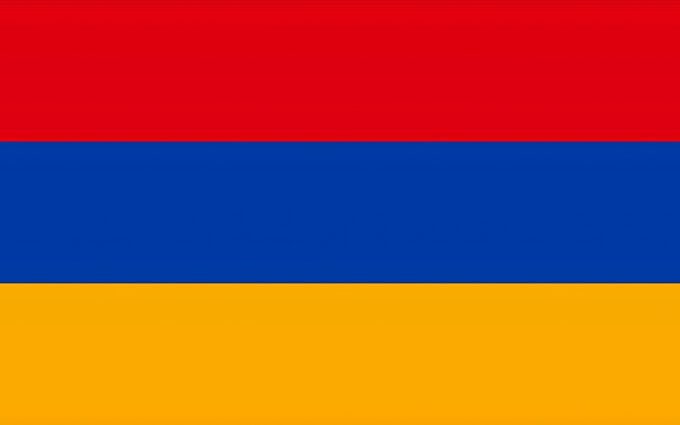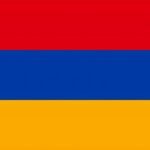Armenia Flag: National Flag of Armenia Free Download

Introducing the National Flag of Armenia: Symbol of Identity and Pride
Flags have always played a significant role in representing a country’s identity and values. The national flag of Armenia is no exception. With its unique design and rich symbolism, the Armenian flag is a source of pride for its citizens and a symbol of the nation’s history and culture.
A) What do the three colors in the Armenian flag represent?
The Armenian flag consists of three horizontal stripes of equal width – red on top, blue in the middle, and orange on the bottom. Each color in the flag holds symbolic significance for Armenia. The red color represents the blood shed by Armenian soldiers in various battles throughout history, as well as the struggle for freedom and independence. It serves as a reminder of the sacrifices made by the Armenian people. The blue color represents the Armenian people’s determination to live beneath peaceful skies. It symbolizes the hope for a peaceful future and the commitment to building a prosperous nation. The orange color represents the fertile lands of Armenia and the hardworking nature of its people. It signifies the country’s agricultural heritage and the importance of the land for sustenance and economic growth.
1. What is Armenia famous for?
Armenia is famous for its rich history, stunning landscapes, and cultural heritage. Here are some of the things Armenia is renowned for:
1. Ancient Civilization: Armenia is one of the oldest countries in the world, with a history dating back over 3,000 years. It is known for its ancient archaeological sites, including the UNESCO World Heritage Site of the Armenian Highlands.
2. Mount Ararat: The iconic Mount Ararat is a symbol of Armenia and is believed to be the resting place of Noah’s Ark. Though the mountain is currently located in Turkey, it holds great cultural and historical significance for Armenians.
3. Armenian Genocide: Unfortunately, Armenia is also known for the Armenian Genocide, which took place during World War I. It was a tragic event that resulted in the loss of a significant portion of the Armenian population.
4. Armenian Apostolic Church: Armenia is the first country to adopt Christianity as its state religion. The Armenian Apostolic Church is an ancient Christian denomination with its own distinct traditions and practices.
5. Cultural Heritage: Armenia is famous for its rich cultural heritage, including traditional music, dance, art, and literature. The country has produced renowned artists, musicians, and writers throughout history.
6. Apricot: Armenia is often referred to as the “Land of Apricots” as it is believed to be the birthplace of this delicious fruit. Apricots hold a special place in Armenian cuisine and culture.
2. Why is Azerbaijan attacking Armenia?
The conflict between Azerbaijan and Armenia primarily stems from the long-standing territorial dispute over the region of Nagorno-Karabakh. Nagorno-Karabakh is a predominantly ethnic Armenian region located within the internationally recognized borders of Azerbaijan. The conflict dates back to the early 20th century when both Armenia and Azerbaijan were part of the Soviet Union. After the collapse of the Soviet Union in 1991, tensions escalated into a full-scale war between Armenia and Azerbaijan, resulting in the occupation of Nagorno-Karabakh and several surrounding territories by Armenian forces. Azerbaijan considers Nagorno-Karabakh and the surrounding territories as its sovereign territory and seeks to regain control over them. Armenia, on the other hand, supports the self-determination of the ethnic Armenian population in Nagorno-Karabakh and advocates for their independence or integration with Armenia. The conflict has seen periodic escalations and ceasefire violations over the years, with the most recent major outbreak of hostilities occurring in September 2020. The situation remains tense, with sporadic clashes and negotiations for a peaceful resolution ongoing.
3. Is Armenia mentioned in the Bible?
Yes, Armenia is mentioned in the Bible. The region that encompasses present-day Armenia is referred to as Ararat in the Bible. Mount Ararat, located in modern-day Turkey but historically associated with the Armenian Highlands, is mentioned in the story of Noah’s Ark. According to the biblical account, after the Great Flood, Noah’s Ark came to rest on the mountains of Ararat. This association has contributed to the significance of Mount Ararat in Armenian culture and its portrayal as a symbol of national identity. Additionally, the region of Ararat is mentioned in various other biblical contexts, including references to its geographical location and historical events.
4. Did Armenia change its flag?
No, Armenia has not changed its flag since gaining independence from the Soviet Union in 1991. The current flag, with its three horizontal stripes of red, blue, and orange, has been in use since that time. The flag was designed by Stepan Malkhasyan and was officially adopted by the Armenian Supreme Soviet on August 24, 1990, as the national flag of the newly independent Republic of Armenia. The colors and symbolism of the flag have remained consistent, representing the historical and cultural significance of Armenia and its people.
5. What is typical Armenian food?
Armenian cuisine is known for its rich flavors, diverse ingredients, and unique combinations. Here are some typical Armenian dishes:
1. Khorovats: Armenian barbecue, consisting of grilled meat, usually pork or lamb, marinated in a mixture of spices and served with various accompaniments.
2. Dolma: Grape leaves or cabbage leaves stuffed with a mixture of rice, ground meat, and herbs. Dolma can be served hot or cold and is a popular dish during festive occasions.
3. Lavash: Traditional Armenian flatbread made from simple ingredients like flour, water, and salt. Lavash is thin and soft, often used to wrap kebabs or served alongside other dishes.
4. Harissa: A hearty porridge made from slow-cooked wheat and meat, usually chicken or lamb. Harissa has a creamy texture and is flavored with butter and spices.
5. Armenian Cheese: Armenia is known for its variety of artisanal cheeses, including the famous string cheese called “sourani” and the aged cheese “lori.”
6. Baklava: A sweet pastry made with layers of filo dough, nuts, and honey syrup. Armenian baklava is often flavored with cinnamon and cardamom. These are just a few examples of the many delicious dishes you can find in Armenian cuisine. The country’s culinary traditions have been influenced by its geography and history, resulting in a unique and flavorful food culture.
6. Is Armenia a rich or a poor country?
Armenia is considered a lower-middle-income country by the World Bank. While it is not among the wealthiest nations, it is also not among the poorest. The country has made progress in various socio-economic indicators since gaining independence, but it still faces challenges in terms of poverty reduction and economic development. Armenia has a mixed economy with sectors such as agriculture, manufacturing, services, and information technology contributing to its GDP. The country has seen growth in industries like IT and tourism in recent years, which have helped boost employment and foreign investment. However, Armenia also faces economic challenges such as high unemployment rates, income inequality, and a significant portion of the population living below the poverty line. The country relies on remittances from Armenians working abroad as an important source of income. Efforts are being made to address these challenges and improve the overall economic situation in Armenia. The government has implemented reforms to attract foreign investment, promote entrepreneurship, and enhance the business environment.
7. Why is Armenia unique?
Armenia is unique for several reasons, including its rich history, cultural heritage, and geographical location. Here are some factors that contribute to Armenia’s uniqueness:
1. Ancient Civilization: Armenia is one of the oldest countries with a continuous history dating back thousands of years. It has a unique cultural heritage shaped by various empires, including the Urartians, Persians, Romans, Byzantines, and Ottomans.
2. Language and Alphabet: The Armenian language has its own unique alphabet, which was invented in the 5th century by Mesrop Mashtots. The alphabet has played a significant role in preserving the Armenian identity and culture.
3. Christianity: Armenia was the first country to adopt Christianity as its state religion in 301 AD. The Armenian Apostolic Church has a distinct religious tradition and is an important part of Armenian culture.
4. Landlocked Country: Armenia is a landlocked country located in the South Caucasus region. Its geographical location between Europe and Asia has influenced its history, culture, and interactions with neighboring countries.
5. Mount Ararat: Although located in present-day Turkey, Mount Ararat is deeply connected to Armenian culture and is considered a national symbol. Its majestic presence and association with biblical narratives make it unique.
6. Resilience and Diaspora: Despite facing numerous challenges throughout history, including the Armenian Genocide and territorial conflicts, Armenians have shown resilience and have formed strong diaspora communities around the world, contributing to global culture, arts, and sciences.
8. Is Armenia friendly to the US?
Armenia and the United States maintain friendly relations. The United States recognized Armenia’s independence in 1991 and established diplomatic relations shortly after. The two countries cooperate in various fields, including trade, education, culture, and security. The United States has provided assistance to Armenia in areas such as democratic governance, economic development, and humanitarian aid. Armenia also benefits from the U.S. government’s support for regional stability and peacebuilding efforts. The United States has been actively involved in the negotiation process between Armenia and Azerbaijan to find a peaceful resolution to the Nagorno-Karabakh conflict. People-to-people ties between Armenia and the United States are also strong, with a significant Armenian diaspora residing in the United States. This diaspora plays an important role in fostering cultural exchange and maintaining connections between the two countries. Overall, while Armenia has friendly relations with the United States, it also maintains relationships with other countries in the region and beyond, based on its foreign policy objectives and national interests.
9. What do the three colors of the tricolor stand for?
The three colors of the Armenian tricolor flag hold symbolic meaning. The red color represents the blood shed by Armenian soldiers in various battles and symbolizes the struggle for freedom and independence. The blue color represents the Armenian people’s determination to live beneath peaceful skies. It signifies the hope for a peaceful future and the commitment to building a prosperous nation. The orange color represents the fertile lands of Armenia and the hardworking nature of its people. It symbolizes the country’s agricultural heritage and the importance of the land for sustenance and economic growth. These three colors together represent the values, aspirations, and history of the Armenian people.
10. What are the colors of Armenian culture?
Armenian culture is not specifically associated with particular colors. However, certain colors are commonly used in traditional Armenian arts, crafts, and textiles, reflecting the country’s cultural heritage. 1. Red: Red is a significant color in Armenian culture and is often associated with strength, courage, and sacrifice. It symbolizes the bloodshed by Armenian soldiers in defense of their homeland. 2. Blue: Blue is a color associated with peace, tranquility, and spirituality in Armenian culture. It represents the Armenian people’s desire for a peaceful future. 3. Orange: Orange is a color associated with the fertile lands of Armenia and the hardworking nature of its people. It symbolizes the country’s agricultural heritage and the importance of the land for sustenance. These colors, along with others, can be found in various aspects of Armenian culture, including traditional costumes, carpets, pottery, and religious art.
11. What is the three-colored flag?
The three-colored flag refers to the national flag of Armenia, which consists of three horizontal stripes of equal width – red on top, blue in the middle, and orange on the bottom. The three-colored flag has been the national flag of Armenia since the country gained independence from the Soviet Union in 1991. It represents the values, history, and aspirations of the Armenian people.
12. What language does Armenia speak?
The official language of Armenia is Armenian. The Armenian language is an Indo-European language and has its own unique alphabet, known as the Armenian alphabet. Armenian is spoken by the majority of the population in Armenia and is also spoken by Armenian communities around the world. It has several dialects, with Eastern Armenian and Western Armenian being the two main branches. Armenian has a rich literary tradition dating back centuries and is an important part of Armenian culture and identity.
B) What Religion Are the Armenians?
The majority of Armenians follow the Armenian Apostolic Church, which is one of the oldest Christian churches in the world. It is an independent Oriental Orthodox church and has its own distinct traditions and practices. However, there are also significant populations of Armenians who belong to other religious groups, including Armenian Catholics, Armenian Evangelicals, and various Protestant denominations.
1. Was Armenia Part of the USSR?
Yes, Armenia was a part of the Soviet Union (USSR) from 1922 to 1991. After the Bolshevik Revolution in 1917, Armenia became a Soviet Socialist Republic and remained under Soviet rule until the dissolution of the USSR in 1991. During this period, Armenia experienced significant political, social, and economic changes as a result of its integration into the Soviet system.
2. Is Armenia a Russian Ally?
Armenia has historically maintained close ties with Russia, and the two countries have a strategic partnership. Armenia is a member of the Collective Security Treaty Organization (CSTO), which is a military alliance led by Russia. Additionally, Russia has a military base in Armenia and provides economic and political support to the country. However, it is important to note that Armenia also maintains relations with other countries and pursues a multi-vector foreign policy.
3. What Was Armenia Called Before?
Armenia has had various names throughout history. In ancient times, it was known as Urartu, and later as the Kingdom of Armenia. During the medieval period, it was part of the Byzantine Empire and was referred to as Lesser Armenia or Cilician Armenia. In more recent history, it was part of the Russian Empire and later the Soviet Union. The name “Armenia” has been used consistently since the country gained independence in 1991.
4. What Nationality Is Armenian?
Armenian is both an ethnic and national identity. Armenians are an ethnic group native to the Armenian Highlands, which is the historical homeland of the Armenian people. The majority of Armenians live in Armenia, but there are also significant Armenian diaspora communities around the world. Armenian nationality is based on citizenship, and individuals who hold Armenian citizenship are considered Armenian nationals.
5. Is Armenia an Arab Country?
No, Armenia is not an Arab country. It is a landlocked country located in the South Caucasus region of Eurasia. The majority of the population in Armenia is of Armenian ethnicity, and the official language spoken is Armenian.
6. Is it Safe to Travel to Armenia?
Yes, Armenia is generally considered a safe country to travel to. It has a low crime rate, and tourists are unlikely to encounter any major safety concerns. However, like any other destination, it is always advisable to take normal precautions and be aware of your surroundings.
7. Is Armenia the Oldest Country?
Armenia is often referred to as one of the oldest countries in the world. It has a rich history that dates back thousands of years. The Armenian civilization is known to have existed since at least the 6th century BC, making it one of the oldest continuously inhabited regions in the world. However, it is important to note that the concept of a “country” as we understand it today may not have existed in the same form during ancient times.
Conclusion
The national flag of Armenia is more than just a piece of cloth. It is a symbol of the Armenian people’s identity, history, and aspirations. The flag’s design and colors hold deep meaning and reflect the values and spirit of the nation. By understanding the symbolism and etiquette associated with the Armenian flag, we can appreciate its significance and show respect for the Armenian people and their rich culture.
Categories : Armenia
Views : 24 Views
Downloads : 0
Tags : Armenia Flag
Author : Admin
Description : Download Armenia Flag: National Flag of Armenia Free Download HD Widescreen Flag from the above resolutions from the directory Armenia. Posted by admin on May 1, 2024 If you don’t find the exact resolution you are looking for, then go for Original or higher resolution which may fits perfect to your desktop.
Rate This Flag:Download Flag
HD Resolution : 1280x720 1366x768 1600x900 1920x1080 2560x1440
Mobile VGA : 240x320 480x640 320x240 640x480 Mobile iPhone : 960x640 1136x640 1134x750 2208x1242
Tablet Android/iPad : 1024x768 1280x1280




Comments